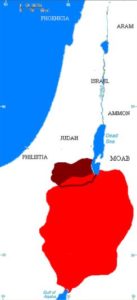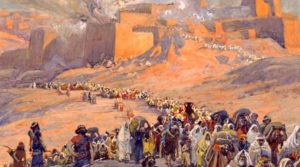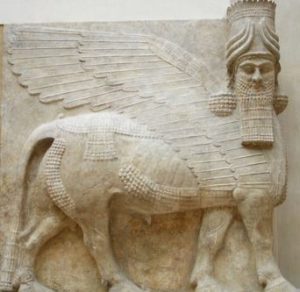In this week’s parasha, Noach, we read about the Great Flood that “reset” the world millennia ago. The reason for the Flood is given in one terse sentence right at the beginning of the parasha: “The Earth became corrupt before God; the Earth was filled with hamas.” (Genesis 6:11) Two verses later, we are again told: “God said to Noah: ‘I have decided to put an end to all flesh, for the Earth is filled with hamas because of them, so I will destroy them with the Earth.’” The mysterious word hamas appears just a few more times in the Torah. It is typically translated as “violence” or “lawlessness”. Rashi (Rabbi Shlomo Itzchaki, 1040-1105) comments here that hamas is gezel, “theft” or “robbery”. Chizkuni (Rabbi Hezekiah ben Manoach, c. 1250-1310) explains that hamas is a particular type of theft or robbery accomplished through subterfuge and manipulation. He brings verses from other places in Tanakh that use this term to show that it can also mean sexual sin, idolatry, and the shedding of innocent blood. The Ibn Ezra (Rabbi Avraham ben Meir ibn Ezra, 1089-1167) adds that hamas refers to the abduction of women against their will. As we’ve horrifically witnessed in recent days, all of these are accurate descriptions of the group that calls itself Hamas, an organization that is violent and manipulative, a band of thieves who abduct, rape, and pillage, shed the blood of innocents—and do it all supposedly in the name of Allah, a most-appalling act of idolatry.

Countries that designate Hamas as a terrorist organization.
This is certainly not a coincidence. It appears that long ago the Torah encoded and predicted the rise of yet another Hamas that would wreak destruction upon the world. In fact, every instance of hamas in Tanakh seems connected to the terror group Hamas. The third case after the two above is when Sarah vented to Abraham her frustration with the pregnant Hagar, saying hamasi aleikhah (Genesis 16:5). Of course, Hagar would go on to give birth to Ishmael, forefather of the Arabs and spiritual father of Muslims. This makes a clear link between hamas and Ishmael, so that we would know exactly who they are!
The next instance of hamas in the Torah is connected to Simon and Levi’s surprise-attack upon the people of Shechem. On his deathbed, their father Jacob reproved them for the massacre, and said they should not have taken up klei hamas against their neighbours (Genesis 49:5). The next two cases both invoke ‘adei hamas, lying and conspiring false witnesses (Exodus 23:1 and Deuteronomy 19:16). Lying eye-witnesses and staged “Pallywood” videos are a classic tool in the Hamas book of tricks. This was most apparent in the recent errant rocket that landed short in the parking lot of a Gaza hospital. A minor event with minimal damage was creatively transformed into a “major attack” by Israel upon a hospital that supposedly killed hundreds. The whole thing was an elaborate lie, but the media ate it up and demonized Israel instantly without bothering to check the facts.
King David presciently foresaw the lying media in Psalm 58, which he began by saying that those who are looked upon to speak truth and justice instead have “wrongdoing in their hearts”. They have blood on their hands, too, for they collude with those ba’aretz hamas (58:3). In Psalm 11 he reminds us that “God seeks out the righteous man, but loathes the wicked one who loves hamas.” They will get their comeuppance, and “He will rain down upon the wicked blazing coals and sulfur; a scorching wind shall be their lot. For God is righteous and He loves righteous deeds; the upright shall behold His face.”
Meanwhile, Ezekiel spoke at length about the final war at the End of Days (Ch. 38-39), then described the Third Temple and the outlines of a rebuilt Jewish kingdom. He quotes God as chastising the failed leaders of Israel: “Thus said the Lord God: Enough, leaders of Israel! Make an end of hamas and crime, and do what is right and just! Put a stop to your evictions of My people—declares the Lord God.” (Ezekiel 45:19) We shouldn’t forget that it was the State of Israel’s failed leadership that unilaterally handed over Gaza to the Palestinians back in 2005 and created this mess, while forcefully evicting Jews who had lived there peacefully. And we shouldn’t forget that Israel’s leadership once quietly supported Hamas in the 1980s, hoping to use them as a wedge against Fatah. (This was the same mistake made by the United States in supporting the Mujahideen against the USSR, only to have the same terrorists turn around and attack America some years later.) And where was Israel’s leadership last week? We are all still confounded as to how such a massacre was even possible. Ezekiel tells us that God will hold Israel’s leaders to account. And he makes it clear that the leaders of Israel must “do what is right and just” and finally end hamas v’shod for good.
That second term shod (שד) is typically translated as “crime” or “rapine”. However, the same word with the same spelling is shed, a demonic force. When we look at the recent crimes of Hamas—which they proudly displayed for the whole world—there is no doubt that the demonic was involved. No human being could commit such crimes without assistance and inspiration from the Sitra Achra, the “Other Side”, the realm of evil. It isn’t surprising, therefore, that our Sages centuries ago described that there are those within the House of Ishmael that are likened to “demons of the outhouse” (Kiddushin 72a). Interestingly, the numerical value of hamas (חמס) is 108, equal to Gehinnom (גיהנם). In Reishit Chokhmah, we learn that there are three origins or “gates” to Gehinnom: in the sea (ים), in the wilderness (מדבר), and in a settlement (ישוב). One can immediately see a connection to Hamas’ recent three-pronged attack, with an invasion by sea landing at the Zikim Beach, an attack on a nature party in the wilderness, and into Sderot and surrounding settlements. This was a massacre straight out of Hell.
It is worth concluding with a Mishnah in Eduyot (2:10) which suggests that five things last exactly one year or twelve months: the Flood, the suffering of Job, the plagues in Egypt, the forthcoming war of Gog u’Magog, and the judgement of the wicked in Gehinnom. This ties everything together: we began with the Flood, where the notion of hamas is first introduced; and our suffering today is much like the suffering of Job, who tragically lost all of his children, his home, his wealth and health, and even his faith. The Prophets compare the events at the End of Days to those in ancient Egypt (and say that Pesach seders in the future will recount not just the Exodus but also the salvation at the End of Days). And we hope to be in the final Gog u’Magog war now, when all evil and all the forces of Gehinnom will be defeated for good. This was foreseen by Isaiah, who declared that “No more shall hamas be heard in your land, nor shod or ruin within your borders” (Isaiah 60:18).
Let us pray that we see this day very soon.







